Who Controls the User Experience? AMD’s Carrizo Thoroughly Tested
by Ian Cutress on February 4, 2016 8:00 AM ESTBenchmark Results: CPU Short Form
Here are our results from our CPU tests. A reminder of our systems:
| System Overview | |||||
| µArch | APU | Base / Turbo MHz | Memory | Channel | |
| HP Elitebook 745 G2 | Kaveri | A10 PRO-7350B (19W) | 2100 / 3300 | 8 GB | Dual |
| HP Elitebook 745 G3 | Carrizo | PRO A12-8800B (15W) | 2100 / 3400 | 4 GB | Single |
| Toshiba Satellite E45DW-C4210 |
Carrizo | FX-8800P (15W) | 2100 / 3400 | 8 GB | Single |
| HP Pavilion 17z-g100 |
Carrizo | A10-8700P (15W) | 1800 / 3200 | 8 GB | Single |
| Lenovo Y700 | Carrizo | FX-8800P (35W) | 2100 / 3400 | 16 GB | Single |
Three Dimensional Particle Movement (3DPM)
3DPM is a self-penned benchmark, derived from my academic research years looking at particle movement parallelism. The coding for this tool was rough, but emulates the real world in being non-CompSci trained code for a scientific endeavor. The code is unoptimized, but the test uses OpenMP to move particles around a field using one of six 3D movement algorithms in turn, each of which is found in the academic literature. This test is performed in single thread and multithreaded workloads, and uses purely floating point numbers. The code was written in Visual Studio 2008 in Release mode with all optimizations (including fast math and –Ox) enabled. We take the average of six runs in each instance.
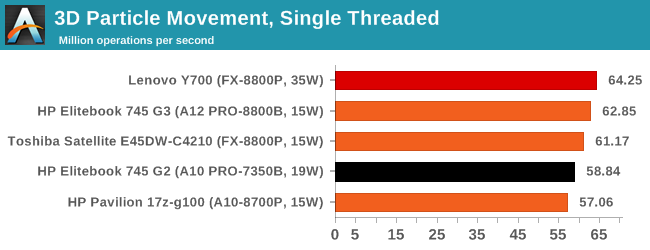
In the single threaded mode, the 35W part is able to boost to a higher frequency, giving it the lead. The interesting element here is the mix of 15W and 19W results, putting the Pavilion with the A10-8700P at the bottom. This comes through in the frequency charts, where the Kaveri was able to boost above 3000 MHz often:
For multithreaded:

The processors line up more as expected, with the 8800P still taking the top spot with Carrizo’s architecture resources showing the ability to scale better.
WinRAR 5.01
WinRAR is a compression tool to reduce file size at the expense of CPU cycles. We use the version that has been a stable part of our benchmark database through 2015, and run the default settings on a 1.52GB directory containing over 2800 files representing a small website with around thirty half-minute videos. We take the average of several runs in this instance.
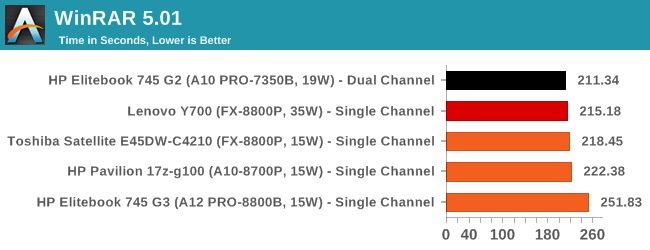
WinRAR is a benchmark which loves DRAM speed, hence why the dual channel Kaveri system wins despite the increased horse power and thermal benefits of the Lenovo Y700. Unfortunately, the single channel design methodology permeates through the OEMs because of the factor of price and upgradability – if a machine is sold with only one module, it can be upgraded later. The other element is that the Y700 design also caters for Carrizo-L as pin compatible, so despite having two modules in there the system will always be limited to single channel. This is, perhaps, a grave error with any situation that is memory limited.
POV-Ray 3.7 beta
POV-Ray is a common ray-tracing tool used to generate realistic looking scenes. We've used POV-Ray in its various guises over the years as a good benchmark for performance, as well as a tool on the march to ray-tracing limited immersive environments. We use the built-in multithreaded benchmark.
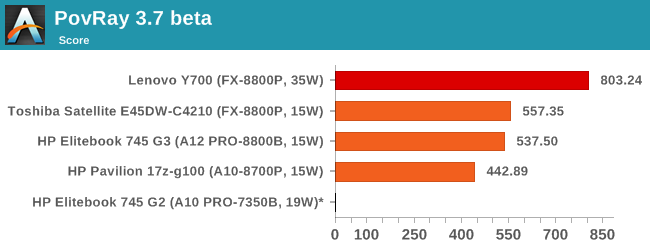
For whatever reason, our script failed to record the score when it came to the Kaveri system and we only realized after the systems were returned. Nonetheless, the capabilities of the other systems shine through, showing that the A10-8700P can seem to have a big frequency discrepancy against the FX-8800P models. In actual fact this can be attributed to the temperature limitations on the Pavilion:
The full threaded nature of POV-Ray means that we’re on the limits of the A10 APU already, but when the system hits 55C or so, it clocks back to 2100 MHz to save a few extra degrees.
If we compare that to the Toshiba:
The Toshiba system also hits a temperature limit, but the barrier is way up at 70C, causing the system to knock back to 64C. The CPU frequency difference between the two does not look that different despite the +25% score in favor of the Toshiba, making it slightly deceptive.
HandBrake
HandBrake is a freeware video conversion tool. We use the tool in to process two different videos - first a 'low quality' two hour video at 640x388 resolution to x264, then a 'high quality' ten minute video at 4320x3840. The low quality video scales at lower performance hardware, whereas the buffers required for high-quality can stretch even the biggest processors. At current, this is a CPU only test.
Unfortunately HandBrake also had issues on a couple of systems – the Lenovo and the Toshiba. All the HP systems gave results, where the HP Pavilion came out on top:


If we compare CPU use, the HP Pavilion is much better at using all of its threads than the Elitebook 745 G3:
7-Zip
7-Zip is a freeware compression/decompression tool that is widely deployed across the world. We run the included benchmark tool using a 50MB library and take the average of a set of fixed-time results.
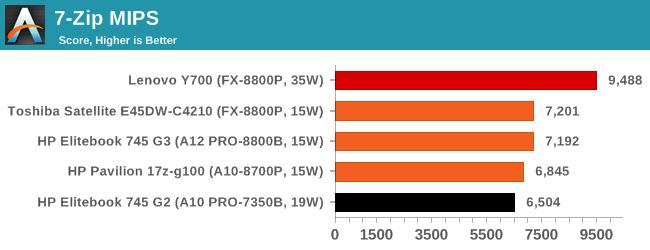
Despite being a purely in-memory benchmark, the G2 shows some inefficiency compared to the Carrizo systems. The slight discrepancy between the 8800 and 8700 shows again, and the Y700 can stretch its legs. Interestingly, the Y700 was able to keep its full CPU frequency on all the time:
Despite the temperature of the CPU moving between 55C and 65C, the system never once reduced its frequency.







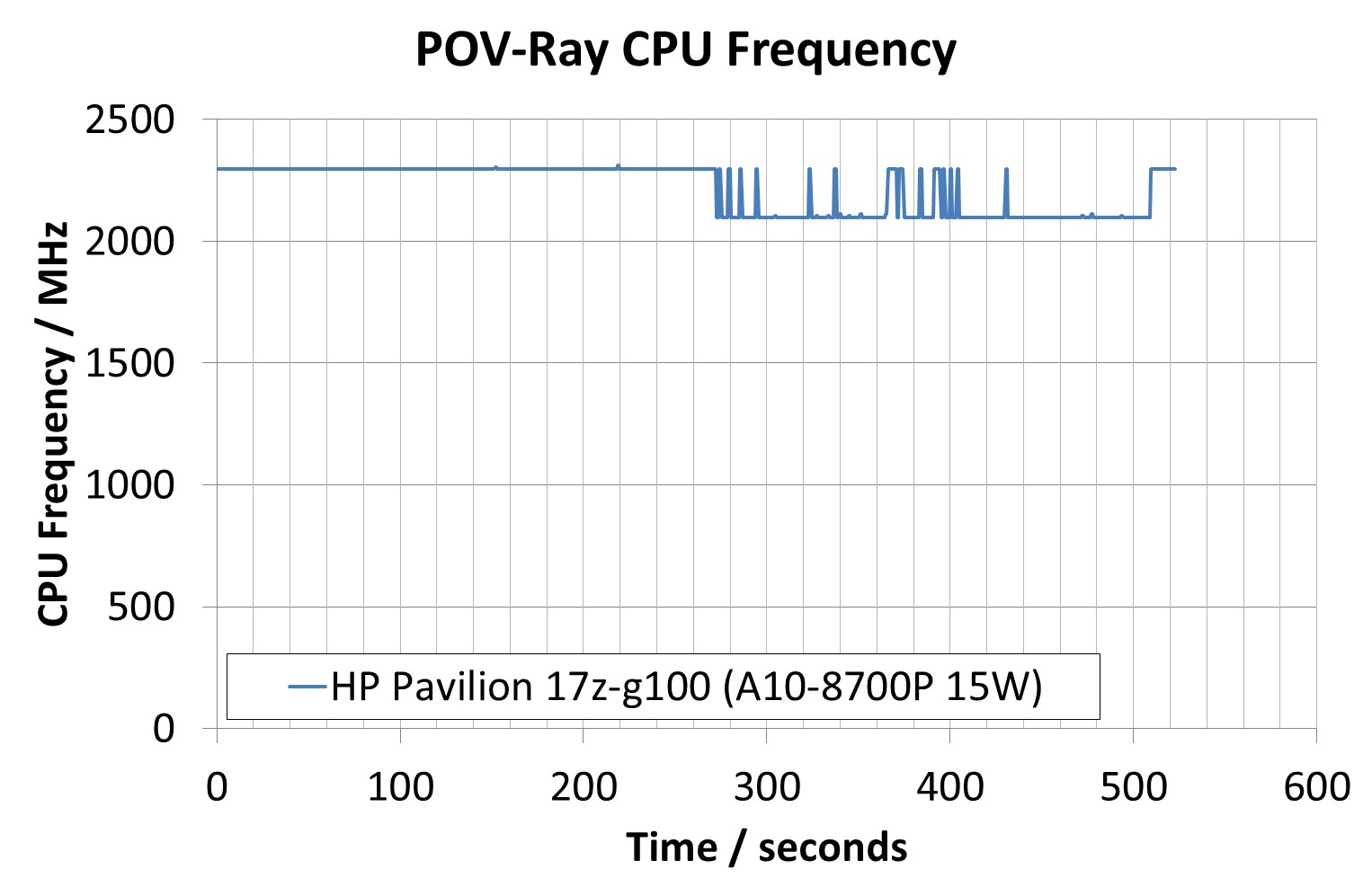
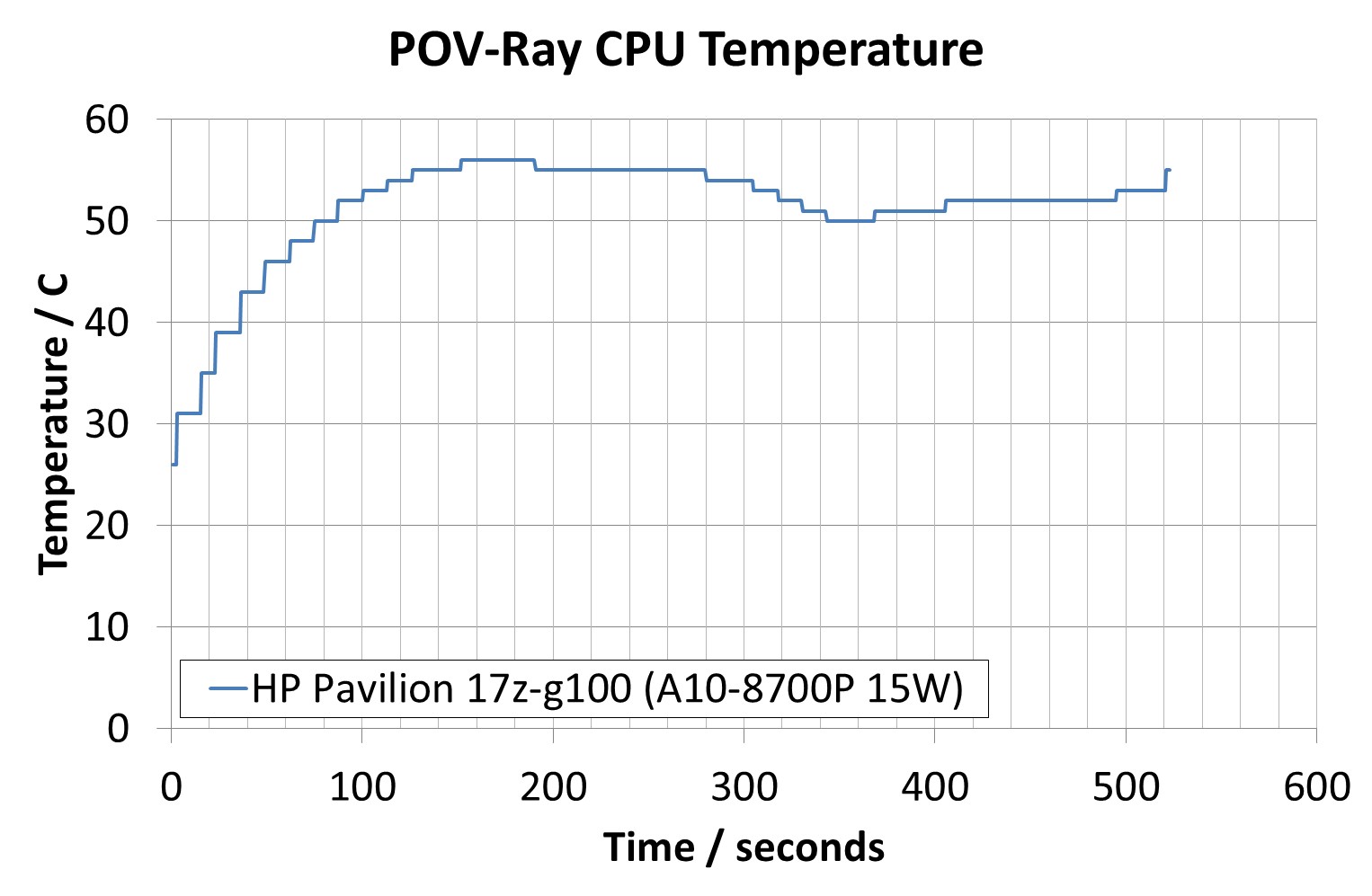


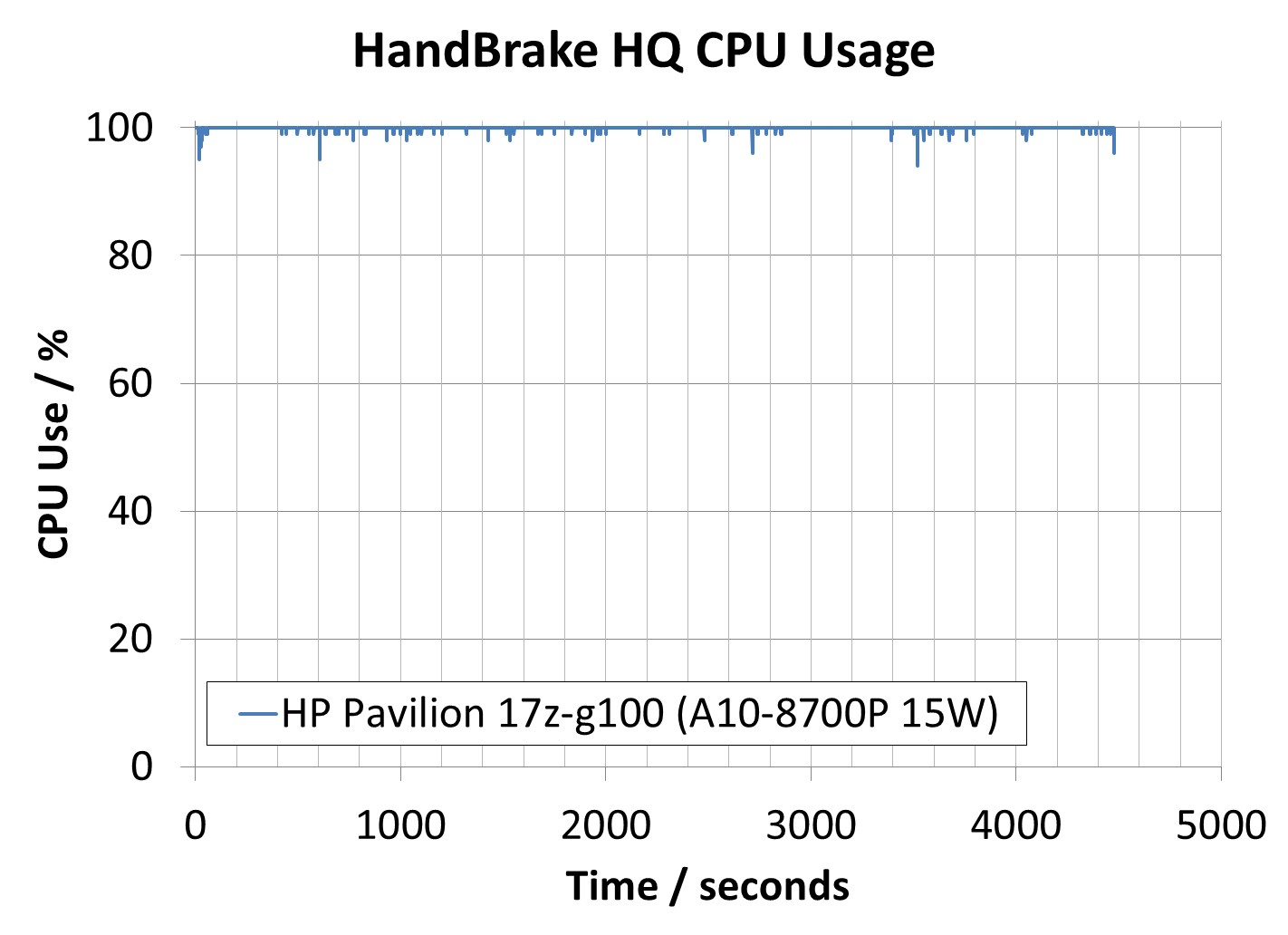

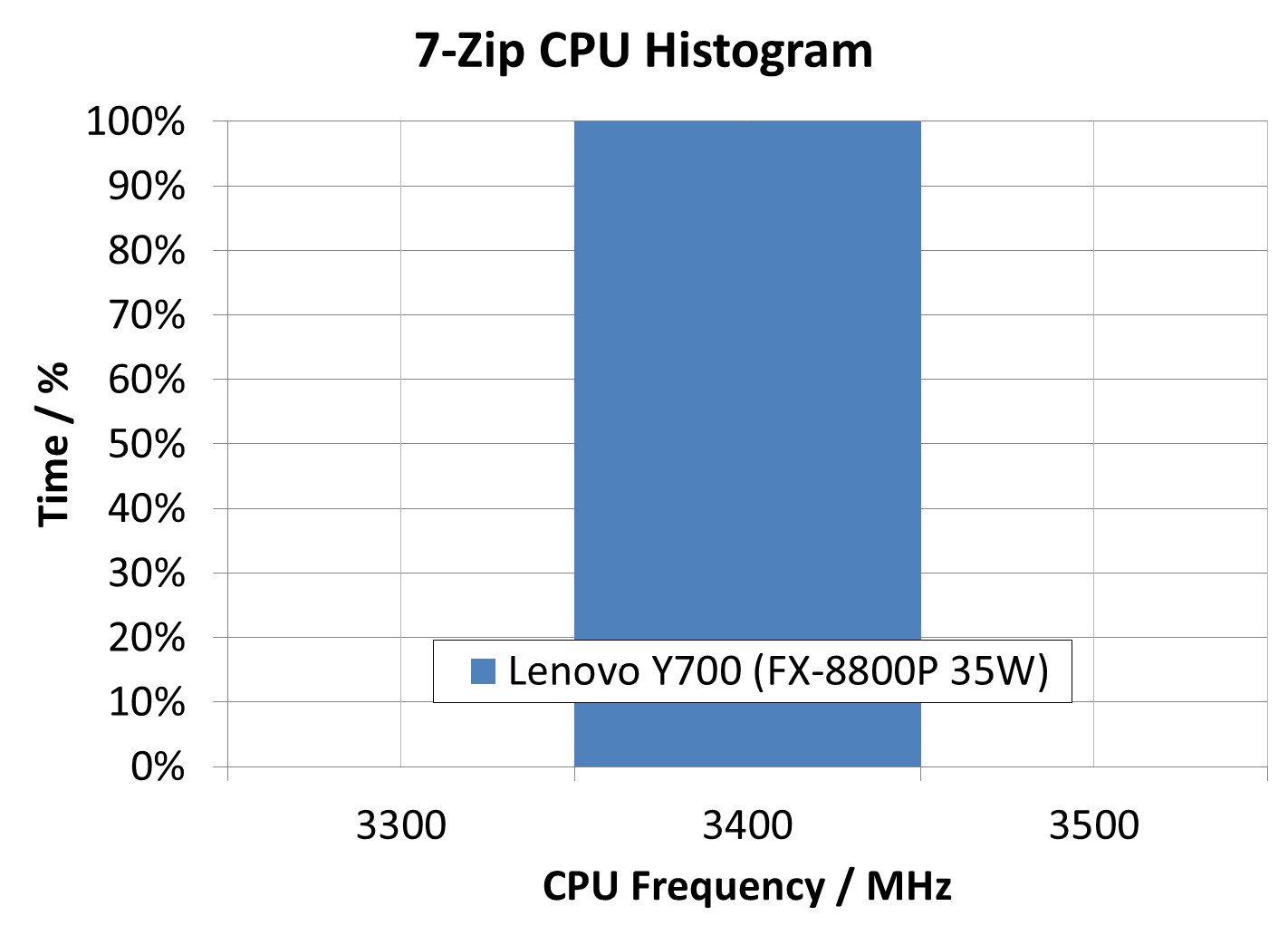









175 Comments
View All Comments
Danvelopment - Monday, February 8, 2016 - link
Strategy AMD should adopt:90% of people don't notice a performance difference above 3000 Super CPU Points, Intel CPUs are usually 4000-8000 Super CPU points, our chips may only range from 3500-4500 Super CPU Points but regular users won't actually notice it, and at the same performance marks we're a hundred dollars cheaper. Make the sensible choice.
Another way, we've done extensive testing to see what end users want and need, then we targeted those sectors, and where we matched Intel we made sure we were a hundred bucks cheaper on the same devices.
"We don't hold the performance crown but the price/performance crown"
Marcelo Viana - Monday, February 8, 2016 - link
Dammit, the solution should be simple, but must come from AMD, since can't expect it from oem's and all of them offer let's say 2011 sockets as example, why amd do not develop a socket switch, so a small board with 2011 pins on the bottom and a circuit on this boad to give a whatever socket amd choose connections on top of it, in order to accept amd chips.But AMD must understand that the memory on their chips must be ddr4(Carrizo do), because the lazy OEMs whon't change memory sockets, as example.
In this case the lazy ones have only to change the chip, and even better if any consumer have a old machine can upgrade to a chip that they choose. simple as that.
Anyone that sales more creates the standard on the market, the others is that must follow.
So who control the user experience? I think no one. everyone in the process just looking to explore the users in order to get money nothing more, but if i have to guess, problably the users. Because they are the one that really have the power to say "i won't buy it or that' or even better "until they give to me what i want" just my 2 cents.
farmergann - Tuesday, February 9, 2016 - link
Seems like you missed out on some highlights of the Y700. The memory is dual channel, the IPS screen has Freesync, and the sound is surprisingly awesome. Replaced the HDD with a Samsung 850 Pro and have thoroughly enjoyed it since.bitech - Tuesday, February 9, 2016 - link
Lol have they never seen a 17" laptop before? The HP Pavilion has a 1600x900 because it's 17". 1600x900 is the minimum resolution on all 17" laptops, not 1366x768.UtilityMax - Wednesday, February 10, 2016 - link
1600x900 is still a crappy resolution for such a large screen. I had a notebook with 15.5 inch 900p screen, and it was visibly grainy.mosu - Tuesday, February 9, 2016 - link
Just few words: Sabotage and corruption at high level OEM decision level. Simple as that.Arief Sujadmika - Wednesday, February 10, 2016 - link
AMD just need a feature to turn off the chips if its detect single channel memory for Carrizo then the OEM will make dual channel memory for it...thatthing - Wednesday, February 10, 2016 - link
the y700 r9 385x is a bonaire gpu, amd has no 512sp chips mobile r9 series, http://www.amd.com/en-us/products/graphics/noteboo...silverblue - Wednesday, February 10, 2016 - link
Articles like these make me want to see how good the unrestricted Athlon X4 845 will be, however as it's probably defective Carrizo silicon, I wouldn't expect it to be massively frugal. I do wonder if there will be any Bristol Ridge Athlons; the top models are rated with a cTDP of 25-45W which is a decent improvement and would reduce/eliminate throttling. Overclocking may not help in terms of power but performance would be more consistent. You also get DDR4 which isn't as big a help for the Athlons but it would be interesting to see the difference.A review of the Dell Inspiron I3656-7800BLK would be a good marker, if only to show the maximum performance of the mobile chips.
Masospaghetti - Wednesday, February 10, 2016 - link
Seems like the best configuration of a Carrizo machine would be a 35w TDP A12 with dual channel memory and integrated graphics (or discrete graphics with crossfire enabled).It's a shame that all of the machines available are severely compromised with either single channel memory, 15w TDP, lack of crossfire, or a combination of these. Seriously. The machines tested have terrible designs. Looks like AMD made a huge mistake providing a common configuration with Carrizo-L with the single channel memory.